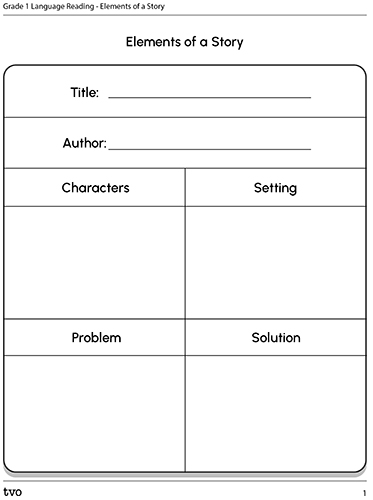Minds On
Identify the different elements
In this learning activity, we will learn to identify the different elements that make up a story.
Exploring a story
In the story, Scribble, some shape friends are surprised when a new friend appears.
Explore this video to find out more about these friends.
Once you have explored the video, consider the following questions:
- What happens in the beginning, middle, and end of the story?
- What other elements does the story have?
Action
Characters, setting, problem, and solution
In addition to the beginning, middle, and end, every fiction story has four elements:
- Where? On the French River.
- When? Long, long ago.
- The resolution usually happens at the end, but not every problem has a solution.
- Stretch your thinking: Every story has a conclusion or ending. Sometimes the conclusion is also a solution.
Exploring Scribble
Student Success
Think-Pair-Share
Let’s return to the story Scribble by Ruth Ohi. If possible, with a partner, think about the story’s four elements (characters, setting, problem, and solution). Hint: Use the questions from the section we previously explored.
Complete the Elements of a Story chart in your notebook or use the following fillable and printable document. If you prefer, you can use another method to record your ideas.
|
Title:(Blank) Author:(Blank) |
|
|---|---|
|
Characters |
Setting |
|
Problem |
Solution |
Note to teachers: See your teacher guide for collaboration tools, ideas and suggestions.
Check your work
Was it easy or hard to identify the four elements? To check your work, press ‘Scribble: Elements of the Story.’
Scribble: Elements of the Story
|
Title: Scribble Author: Ruth Ohi |
|
|---|---|
|
Characters |
Setting |
|
In their playground |
|
Problem |
Solution |
|
Scribble is not a shape like circle, triangle, or square. When Scribble asks to play, Triangle and Square do not want to play. |
Circle and Scribble play together and have fun learning all of the exciting things that Scribble can do. |
You pick the story…

Select a book or an audiobook that you like. You will identify its characters, setting, problem, and solution.
Student Tips
Consider rereading
You might want to pick a story that you’ve read before by yourself or with an adult.
Complete the Elements of a Story chart in your notebook or use the following fillable and printable document. You can draw pictures or write words in the boxes. If you prefer, use another method of your choice to record your ideas.
|
Title: (Blank) Author: (Blank) |
|
|---|---|
|
Characters |
Setting |
|
Problem |
Solution |
Consolidation
Identifying elements

Student Success
Think-Pair-Share
When you’ve completed your Elements of a Story chart, reflect on your story’s characters, setting, problem, and solution. Consider:
- How are the story elements in this story similar to other stories you have read?
- How are they different?
If possible, with a partner, share your story elements.
Note to teachers: See your teacher guide for collaboration tools, ideas and suggestions.
Reflection
How do you feel about what you have learned in this activity? Which of the next four sentences best matches how you are feeling about your learning? Press the button that is beside this sentence.
I feel...
Now, record your ideas about your feelings using a voice recorder, speech-to-text, or writing tool.
Press ‘Discover More’ to extend your skills.
Discover MorePick one of these two options:
- Return to the story Scribble, and come up with another possible ending. Use any method you like to record your new ending.
- Return to a story of your choice that has an ending, but not a solution. Draw a picture of or describe a possible solution.

